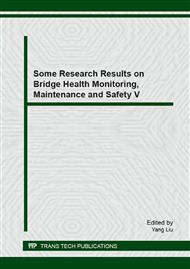p.9
p.17
p.25
p.35
p.45
p.53
p.61
p.72
p.80
Research on Construction Technology of Fixation Stent Installing Comb Expansion Joint
Abstract:
The hot-rolling-whole-molded and comb-type-designed bridge expansion devices are widely used in the urban and highway bridges, owning the characteristics of large expansion allowance and small burial depth. Whereas using traditional craft to install comb-type expansion joint, such phenomenon like settlement, water seepage, bumping and noise in driving would happen with slow construction. Through continuous improvement for many years, Jinan Urban Construction Group has developed a full construction technology of installing comb expansion joint based on fixation stent by using tailor-made location frame to integrally move the anchor bolt group into the groove for firm weld with embedded steel, matching with moving lifting tool. Through this construction technology, the efficiency of construction is improved, the construction period is shortened, and the smoothness of asphalt after installing comb plate would meet the design requirements, also such quality defects like bumping and abnormal sound would be precluded. hot-rolling-whole-molded and comb-type-designed bridge expansion devices
Info:
Periodical:
Pages:
53-60
Citation:
Online since:
June 2015
Authors:
Price:
Сopyright:
© 2015 Trans Tech Publications Ltd. All Rights Reserved
Share:
Citation:


